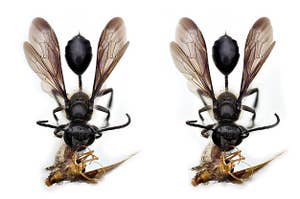
They finally trust me enough! Look!
After months of patience and subtle exposure, the juvenile hummingbirds finally trust Annette and I enough to sit on our fingers!!!! So exciting! Up to four juvenile ruby-throated hummingbirds have been hanging around my feeder all day long. They let me get so close that I can actually take handheld stills of them at manual focus with an 18-55mm lens. This inspired me to capture videos of the birds at varying speeds. A hummingbird can flap its wings at 40-80 times per second. The camera records in real time at 30 frames per second. In the video you will see one male and one female. The plumage on the male appears to be speckled because its plumage has not yet matured. Such a remarkable creature!

Extreme Zooms Of Hummingbird
Hummingbirds are by far one of my favorite animals. I hang a feeder just off the overhang in front of my house and I regularly watch them while I work. I was very sad to come home this morning to find one of the three juvenile females lying still after getting trapped in my window. It was very sad for me to take these images; however, I hope researchers are able to use them positively for research purposes. Please download and use our open source images for your own purposes from our database. If you do, please reference Macroscopic Solutions. All of the images in our database were captured with the Macropod by Macroscopic Solutions. www.macroscopicsolutions.com Click here to see a brief video about Macroscopic Solutions and the Macropod. Click here to see a brief description about the Macropod. Click here to see instructional videos about our techniques. The Macropod is a rigid, portable photomacrography system, which allows the user to make razor sharp, fully focused photographs of small sized specimens at 18 to 26-megapixel resolution. It overcomes the extreme Depth of Field (DOF) limitations inherent in optics designed to image smaller specimens. Normally, lenses designed for macro will only render a very small fraction of the depth of targeted specimen in sharp focus at any one exposure. The Macropod allows the user to select and make multiple exposures in precise increments along the Z-axis (depth) such that each exposure’s area of sharp focus overlaps with the previous and next exposure. These source images are then transferred to a computer and merged by an image-stacking program. The stacking program (Zerene Stacker by Rik Littlefield) finds and stitches together only the focused pixels from each exposure into one image. The Macropod integrates industry-leading components in a novel and elegant way to achieve these results.

3D Steresocopic Creations Of WOW!
To See in 3D: 1) Cross your eyes until the two images merge at the center. 2) Focus in the middle image 3) See in 3D! Stereoscopy (also called stereoscopics or 3D imaging) is a technique for creating or enhancing the illusion of depth in an image by means of stereopsis for binocular vision. Most stereoscopic methods present two offset images separately to the left and right eye of the viewer. These two-dimensional images are then combined in the brain to give the perception of 3D depth. This technique is distinguished from 3D displays that display an image in three full dimensions, allowing the observer to increase information about the 3-dimensional objects being displayed by head and eye movements. For more information about the techniques used to make these images: visit www.macroscopicsolutions.com More coming soon!

